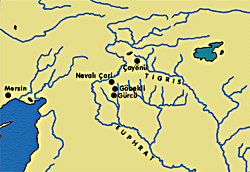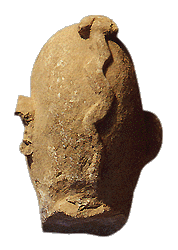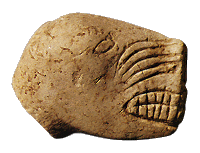 |

Nevali Cori is a settlement of the Pre-ceramic Neolithic A-B (10th-8th millennium BC), that is the early Neolithic period, and is located on the Euphrates (south Turkey). It is the earliest up to now known settlement whose economy was not primarily based on agriculture and farming, but on hunting certain animals (gazelle, deer, wild boar, hare). Specialized hunting techniques led to a huge surplus of animal products whose conservation and storage required the construction of specific buildings, the so-called "Kanalhaeuser". Beneath the stone floor, there were channels a metre apart. These ensured ventilation, refrigeration and insulation against humidity. Apart from hunting, grains and legumes were also cultivated. A palaeoanthropological examination of bones from 50 burials in the area of the settlement has substantiated the variety and great quantity of vitamins obtained by the inhabitants of the settlement during the 9th millennium BC. |
|
In the settlement area a building was unearhted, the so called "Terazzogebaeude" (14X14 m), which stands out because of its heavy sidewalls and its interior design. It is built of stone and its floor consists of smooth and hard lime mortar. Three architectural phases which go back to the Pre-ceramic Neolithic A and B were examined. In the center of the building two pillars stood with a human relief decoration. |

|

The body of a man and an anthropomorphic bird were found during the latest phase. The latter, as well as other monstrous sculptures from the middle phase of the building, belonged to a pillar of 13 m. high. The shape of the building, the type and the disposition of the sculptures (statue of worship, burial?) as well as the varied shapes of the foreign in this region flint arrowheads (from Damascus and elsewhere), leave no doubt as to the character of "Terazzogebaeude": it is the oldest temple of mankind! A building similar to "Terazzogebaeude", but more recent, was found at Cayonu, close to the springs of the river Tigris and dates to the transitional phase from Pre-ceramic Neolithic A to B. At Gobekli Tepe, south-east of Nevali Cori, buildings and many sculptures of the Pre-ceramic Neolithic B were unearthed. Further progress in the excavations will show the importance of this site in the region of Harran. |
 |
 |
 |
 |
 |
 |